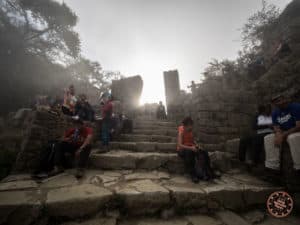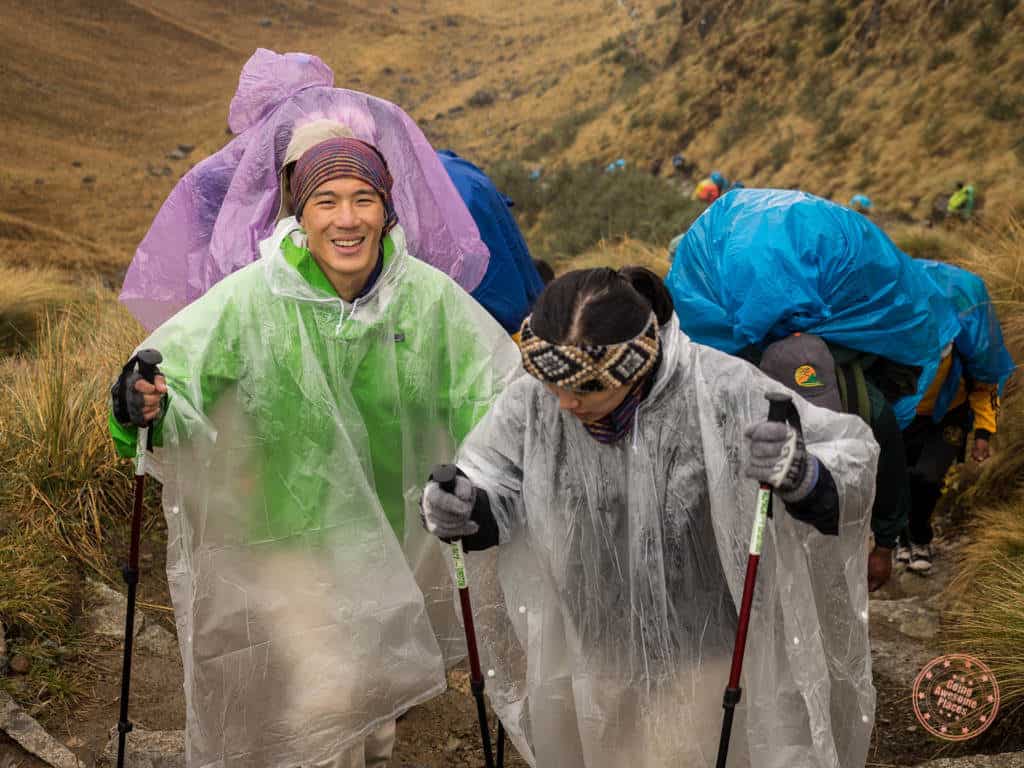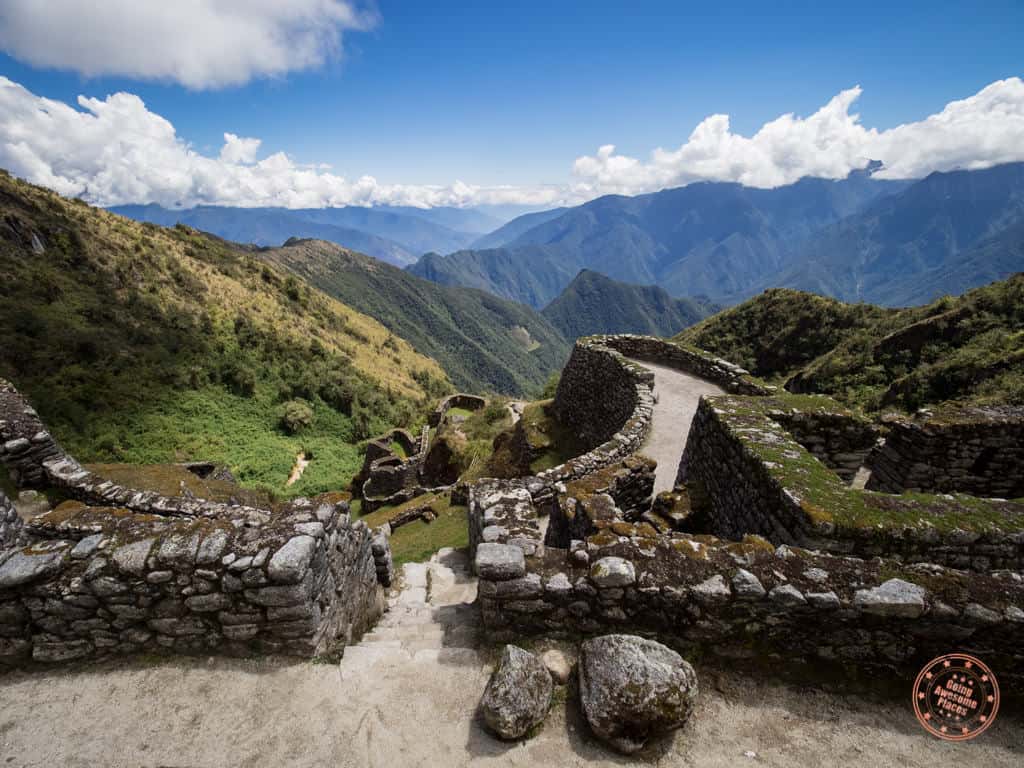It might be one of the most famous archeological sites in the world and that’s why so many travellers are flocking to Peru to see this awe-inspiring ancient city. The classic way to see this wonder is to follow in the footsteps of the Incas and spend 4 days and 3 nights along the trail but I learned quickly that there were just some things that I wasn’t ready for.
Having completed the trek, there were a lot of things I came away with. Here are 9 thoughts on what I learned about hiking the Inca Trail to Machu Picchu.

Read More
- How to pick which Machu Picchu hike to do
- What they don’t tell you about the Inca Trail
- The serious truth about hiking the Inca Trail
- The full Peru 2 week itinerary
- Is Huayna Picchu worth it or not?
Where to stay in Cusco?
- If you’re looking for great places to stay, my recommendation is to take a look on Booking.com. For a really comfortable luxury stay, the Palacio Del Inka was incredible for us but on a budget, we equally loved the Hostal Illapa Inn. For our one night in the Sacred Valley, the Tambo del Inka was another Marriott property that blew us away.
In This Article
- 9 Things I Wish I Knew To Prepare For Hiking The Inca Trail
- 1. Your trekking company matters
- Find the Machu Picchu Hiking Trek For You
- 2. Beware of altitude
- 3. There’s a reason the Inca Trail is so popular
- 4. Why having a private tour was awesome
- 5. The porters are the real super heroes
- 6. Be ready for all seasons
- 7. Shoes matter
- 8. Book as early as possible
- 9. The journey is better than the destination
9 Things I Wish I Knew To Prepare For Hiking The Inca Trail
Depending on what spectrum you’re on, you probably think that hiking the Inca Trail is crazy or it’s going to be cinch. Well, it’s a little bit of both.
I’m dropping truth-bombs all over the place from our own experience hiking to see Machu Picchu. Here are all the things we learned and what I wish I knew before we went.
1. Your trekking company matters

In order to make sure you have the best experience possible along the Inca Trail, the most important decision you’re going to make is picking the right tour operator. With so many to choose from, you might be feeling a little analysis paralysis but this is the kind of thing you don’t want to cheap out on.
Thing is, if you’ve never done a trek like this before, how do you know what to look for in a good trekking company? Here are a few things to look out for when making your decision.
Travelling Your Way

Not all treks are equal. There are so many variations of hikes that’ll eventually lead to Machu Picchu. The most common is the 4D3N (4 days and 3 nights) that’s dubbed the “Classic” but that doesn’t mean it’s the only way to do it.
There are longer ones, shorter ones, different routes, large groups, and private. It all depends on what you’re looking for and as you learn more about what my Classic Inca Trail experience was like, you’ll be able to make a decision about whether you want to do it or if you want to do one of the many alternative types of Machu Picchu hikes out there.
Your guide makes all the difference
The person responsible for getting you through the Inca Trail is critical. He or she is going to be with you every day and will not only show you the way, but is the person you’re going to be counting on for anything unexpected you might need. What you’re looking for is a guide that speaks good English, is knowledgeable about the culture and history, and is prepare to handle any situation that might come up whether it’s medical or something else.
High quality guides have experience with leading hundreds of groups and know how to work with all varieties of travellers. You also want a guide that is local and has that rapport with the porters, and have on-the-ground knowledge of the fascinating history behind the Inca Trail and the anecdotes that will make you go “Wow!”
The little things

Service is everything and on a challenging trek like this, you want to make sure you’re taken care of. Of course, you expect the main things to be covered like the hero-like porters that carry all of your things from campsite to campsite, set up the tents ahead of you, and cook incredible meals but it’s also the small things that count. For example, I appreciated getting a warm towel at the end of the day to clean up or having everything ready in the dining tent when you wake up in the morning.
At the end of the day, the best way to help decide who to choose is going to be based on recommendations of your friends and experts like myself. If I were to do it again, I would definitely go with someone like the World Expeditions which offers a variety of different trek options to suit your needs.
Find the Machu Picchu Hiking Trek For You

World Expeditions is a leading operator of authentic and unique adventure holidays that has trips all over the world. What I love about them is that their approach to travel is all about going off-the-beaten-path, experiencing something extremely local, and having a mindset of responsible tourism by leaving the smallest environmental footprint possible.
2. Beware of altitude

Not that it was a surprise but it was at the same time. Altitude is one of those things that if you’ve never experienced it before, it’s hard to know how it will affect your body. What I’ve told everyone that’s asked me for advice on the Inca Trail is to always prepare for the worst and change your mindset to how you hike.
I’m not going to lie. Altitude beat me up pretty good and it started on the first day. The key I learned was that you can’t expect to be as strong or fast as you are at sea level. Oxygen is at a premium this high up and you have to remember to pace yourself. This means slowing it down by taking nice deep breaths as you’re climbing. It also means that you don’t have to feel like you need to lead the pack. When you over-exert yourself like I did, that’s when your body starts to break down. Lastly, staying hydrated is no joke so make sure you constantly take sips of water and keep your lips moist. That’s where a good hydration pack comes in handy.

When I say that you should “be prepared”, it means you should equip yourself with everything you need in the case that you don’t deal so well with altitude. Prior to heading out to Peru, I made sure to get a prescription of Diamox from my family doctor but what I didn’t think of was to ask for a prescription for serious diarrhea. You also want to have your standard assortment of meds like Tylenol/Advil, Pepto Bismol, and something for a sore throat because that always comes out of nowhere. You’ll also want to make sure to pack toilet paper. Let’s just say I needed it on the hike towards Dead Woman’s Pass.
Luckily, if you’ve forgotten anything, your guide should have you covered as they do carry a comprehensive first-aid kit with them. A friend in my group had serious stomach issues by the second day but luckily our guide had Cipro to help the situation.
On the flip side, everything I’ve said so far can be thrown out the window if your body doesn’t react to altitude at all. You just won’t know until you get up there.
3. There’s a reason the Inca Trail is so popular

I know what you’re thinking. As one of the world’s greatest hikes, isn’t the Inca Trail overdone and overcrowded?
I was worried about that too originally, but I can confidently say that you can put those worries aside because 1) it’s not really really that crowded along the trail and 2) at the end of the day, this trek is the only one that goes straight to the Sun Gate.
There’s a reason why permits are in place for the most popular path up and it’s meant to control how many people go through between all the different outfits per day. While you’re hiking throughout the day, you’ll certainly see other groups but traffic jams never really materialize. You’d also think that Inca ruins and viewpoints would get crowded but I never felt that frustration. It was quite easy to get clean photos where I needed to and there were plenty of times we were all alone.

If hiking early in the morning to watch the sunrise from the final gate before entering Machu Picchu and seeing the clouds break to reveal the ancient city before your eyes is important to you, then the Inca Trail is a no-brainer. It’s the only trek where you can hike straight in without having to take a train and a bus up. Other hike trails may have really amazing features but they will all require you to do the final leg up to Machu Picchu with the rest of the non-trekking tourists. That’s a fact!
4. Why having a private tour was awesome

We debated for awhile whether we should hike in a larger group with other random strangers but ultimately elected for a trek customized just for our group of 4.
It cost us more money but I loved how we received personalized service all the way through. This meant that during the booking process, we didn’t have to worry about fulfilling a minimum group size. While on the trail, it felt like we were one of the slowest groups out there but that didn’t matter because we never had to feel guilty for holding anyone else up because we wanted to take extra photos or were just too tired to go any faster.
5. The porters are the real super heroes

The real heroes of the Inca Trail are the porters. While they often kept to themselves, these were the guys that either stayed behind to pack up all the tents and gear or were way ahead preparing for our arrival after a long day’s trek.
What amazes me was just how fast they are. With nothing more than flip flops and a full load on their back, porters will blaze past you as you’re huffing and puffing along. They seriously have my admiration and respect for doing this week in and week out.
6. Be ready for all seasons

What doesn’t come through in the brochures and guides for the Inca Trail is just how dynamic the climate is. As you’re rising and falling through the altitude and trekking deeper into the mountains, the weather can and will change with the snap of the fingers. You can go from sweating through all your clothes to needing to pull out that emergency poncho to slipping on all your layers as the sun sets.
The key to packing for a trip like this is to make sure you bring layers. Always start with a moisture wicking piece of clothing as your base layer and add on top as needed.
What caught me off guard the most was just how cold it got on the second night. With temperatures dropping down to near 0 degrees celsius, I struggled to sleep despite already having a pair of socks and zip-up sweater on top.
7. Shoes matter

I can’t stress enough how important it is to have a good pair of shoes. You’re going to be on your feet all day so make sure you have a pair that has the grip and the comfort that’ll last even after 10-12 hours of hiking each day.
While the trail itself doesn’t require any vertical climbing or rough terrain, with the changing climate you never know when you’ll need your shoes to power through slippery surfaces. There are also various dirt paths with rocks scattered along the way so having shoes with good grip is important to keep yourself planted.
If you’re buying new shoes for the trip, make sure you buy them a good month beforehand so that you can break them in. This is no joke because one of the friends we were travelling with realized a little too late that her shoes were a tad small and resulted in a few black toenails.
8. Book as early as possible
With tighter and tighter restrictions on permits and more people wanting to do the Inca Trail every year, the general rule of thumb is you should look at booking your trip at least a year in advance at least. You don’t want to be in a situation where you’re ready to book, only to realize that the dates you’ve chosen are already sold out.
Currently 500 permits are issued per day but only 200 of those are for hikers and the rest are for porters, guides, and cooks. Also keep in mind that the trail is closed in February each year.
Still, there are many Peru trekking options to consider beyond the Inca Trail which I won’t be covering here but you should know that all hope is not lost if you find out that the permits are sold out for your desired dates.
9. The journey is better than the destination
Perched in the middle of the Peruvian Andes, Machu Picchu will take your breath away but if you ask me what made the Inca Trail hike special, I’d tell you every time that it was what we went through along the way that made our trip so unforgettable.
As in real life, it’s the struggle and the overcoming of challenges with people you care about that ultimately make it all worth it. Yes, taking a train and bus to Machu Picchu from the comfort of Cusco is really easy to do but my memories of Peru are so much more vivid because we were able to successfully conquer the trail.
The other facet of the journey that surprised me was just how much we were able to see along the route. From terraces to the grand ruins of temples, those moments where we found ourselves alone amongst the perfectly laid stones were surreal and simply perfect. In many ways, I was more impressed with these smaller discoveries than with Machu Picchu because I wasn’t expecting them at all.

So that’s everything that I learned from my Inca Trail trek. There’s so much to unpack here but the bottom line is that if you go in prepared and with the proper expectations, you’re going to have an incredible time out there.
If you’ve come back from your trek already, I’d love to hear from you what you thought of it and have I missed anything here that you think would be valuable for first-timers. Drop a comment below!
What you should read next





